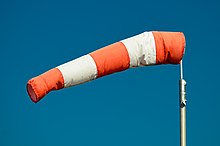Windsock

A windsock is usually made of weather-resistant Nylon - tissue -built, and a tapered, open at both ends hose on a mast is suspended in several meters above the ground rotatably supported. It is blown up by the wind and turned so that the smaller end faces leeward . Thus the windsock shows the wind direction and the approximate wind strength .
commitment
Windsocks are used wherever it is less a matter of obtaining precise data than an easily interpretable, quickly comprehensible display. To avoid accidents, it is particularly important in hectic situations to see the speed and direction of the wind at a glance. If the windsock is slack, there is no wind that can be displayed. If he is standing straight in the horizontal, there is a strong wind.
Most windsocks are divided into bright red and white rings, so they are clearly striped in terms of color. This not only makes it easier to see from a distance or from the air, but also enables a rough estimate of the wind strength. A common rule of thumb is that for each inflated ring, about five knots of wind force are counted.
More precise wind measuring devices are modern wind direction transmitters and anemometers .
aviation
According to the rules of the international aviation organization ICAO , wind direction indicators must be available at all airports and heliports. There they should be clearly identifiable from the air and for pilots on the ground and also have lighting for visual flight at night. A windsock must not be influenced by small-scale air currents (e.g. from engines ) or air turbulence from buildings or vegetation. To make it easier to see from the air, each windsock should be surrounded by a circle, preferably in white.
Road traffic
Windsocks can also be found on numerous roads and bridges where cross winds can be a serious hazard. Here they give drivers the opportunity to adapt their driving style in good time to the prevailing wind conditions, such as a suddenly stronger crosswind on valley bridges . Windsocks are also used in ports, at transfer stations and tank systems, as well as in industry.
Antique "dragon"
The principle of the windsock was already used in antiquity for the army standard draco ("dragon"). The Roman historian Ammianus Marcellinus describes the appearance and function of this Draco in the following words: “Behind many other people marching in front, the emperor was surrounded by dragons made of purple-red fabric, the lance tips tied to gold-plated and decorated with precious stones, blown up by the wind through a large opening could be and so hissed as if angry and held their big tails behind them in the wind. "
Individual evidence
- ↑ Ammianus Marcellinus, Res gestae 16.10: "Eum (sc imperatorem) post antegressos multiplices alios purpureis subtegminibus texti circumdedere dracones hastarum aureis gemmatisque summitatibus inligati, hiatu vasto perflabiles et ideo velut ira perciti sibilantes volumina relumin."


